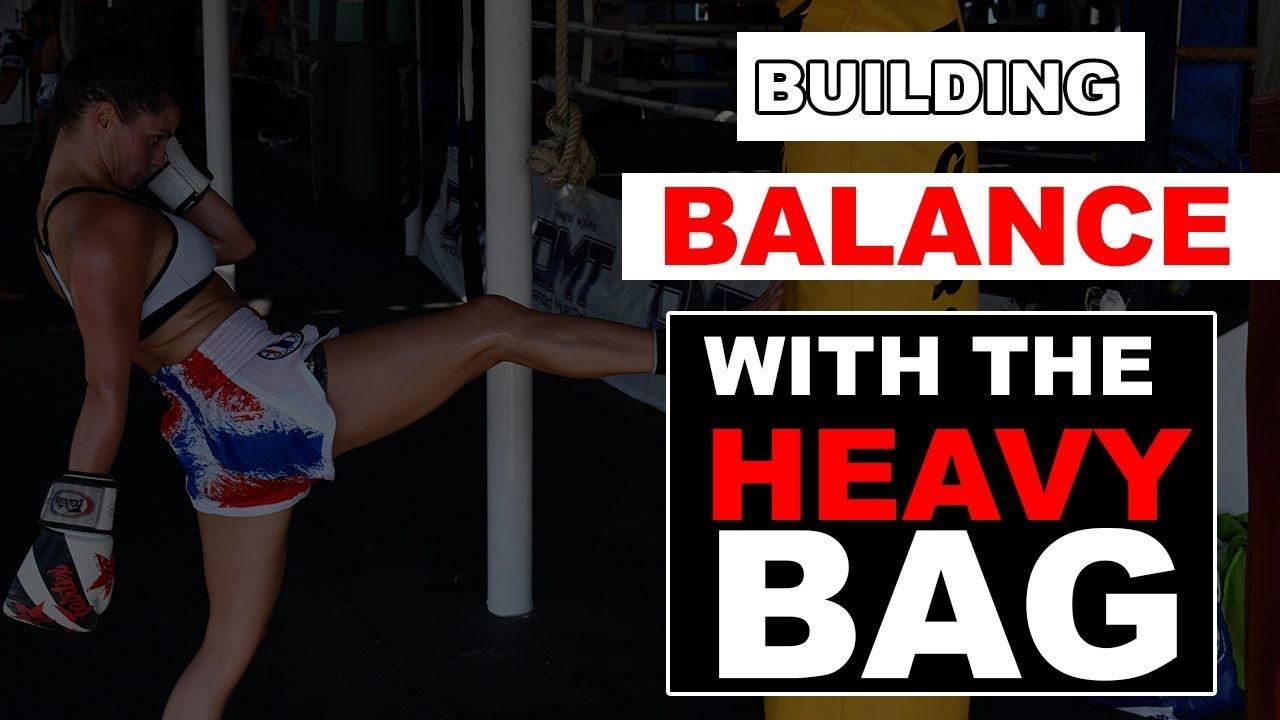Building Balance With The Heavy Bag

3 HEAVY BAG OR SHADOWBOXING DRILLS TO BE MORE BALANCED
By Andrew Bryan

Balance is crucial in any sport. Muay Thai, kickboxing, karate, any sport that requires you to spend a significant amount of time standing on one leg -- these are no exceptions to the rule.
Today we’re going to be looking at how specifically to use the heavy bag to train and improve one's balance, along with modifications for when you don’t have access to your own bag.
Let's dig in.
DRILL #1: Lomachenko Wide Stance Drill
The first and indeed most simple of these exercises is routinely performed by the greatest living boxer, Vasyl Lomachenko. Rather than hitting the bag in your normal fighting stance, instead stand with your feet an unreasonable distance apart -- at least twice shoulder length.
From this stance, we hit the boxing bag with all our usual arsenal (save for kicks and knees). We jab, hook and pivot around the bag like normal, and we try to use as much footwork as we would normally do.
This stance weakens your contact with the ground and makes your muscles have to work harder in order to stay on balance. When you return you training in your normal stance, you will feel rock solid by comparison.
>>> Modification
The modification for this exercise is simply doing the exact same exercise – but without the bag, shadowboxing, or drilling with a partner. Above we have a demonstration from Lomachenko himself.
DRILL #2: The Floor is Lava Drill

If you were ever a child (small likelihood, I know), I can reasonably assume that you spent at least some time jumping around on your disapproving parents' furniture trying not to touch the deadly, volcanic magma that was your living room carpet.
This drill works on the same principle.
You are standing in front of the bag, and only one of your feet is on a safe platform. Everywhere else around you is lava and you have to kick, punch, check kicks, teep and knee the bag, all without your kicking foot touching the ground.
You can bring your foot close to the ground in order to get as close to normal technique as possible, but you cannot touch the ground. (Not unlike a lunge, in which your knee can get awfully close to the floor but shouldn’t touch it.)
You can do the drill as long as you like but one minute on each leg is going to be the best for not overworking your muscles.
This exercise is particularly challenging and even very experienced Thai boxers will struggle with it. If your foot does touch the ground, it’s no great worry; just restart the drill and aim for one minute of work – now with a burned foot, of course.
>>> Modification
The best modification for this drill is Samart Payakaroon’s balance drill (with which I would suggest you get comfortable before attempting our "lava" drill). Without letting your foot touch the floor, you move between a round kick, rear straight punch and a check, then change sides.
For a simpler drill that demonstrates the same balance-positive principles, this Muay Thai Guy workout fits the bill.
Muay Thai Heavy Bag Drill For Kicking Balance
DRILL #3: Floating Check
For those who have experience in East Asian martial arts, such as karate and its off-shoot Taekwondo, or perhaps the various styles of Kung Fu, you will no doubt be familiar with the idea of chambering a kick. Rather than kicking straight to the target with no middle step – like what we see in Indochinese kickboxing styles like Muay Thai and Lethwei, they will instead bring the knee up and into a chambered position, before extending and kicking through the target.
While undeniably awkward to learn at first, it makes for a faster and more balanced kick overall. Unfortunately, it’s also not compatible with a Muay Thai kick due to the difference in how a Thai boxer starts their kick.
That is where the idea of a floating check comes in. After throwing a power kick on the heavy bag, rather than bringing the foot immediately back to the floor, bring the leg back to a checking position. From that check, you have three options:
- Round kick from that checked position
- Return to the floor
- Teep
Alternating between these three movements will allow you to get more control over your kick and help you in recalling the kick after you’ve hit the target.
>>> Modification
Similar to the Lomachenko drill above, the modification here is simple. We do the exact same drill in shadow; however, with nothing to absorb our power, we need to ensure that our kicking technique is flawless.
An easy tip is rather than trying to fully turn your hip all the way over and kick 3 to 9 (a common mistake), kick at an upward angle of 4 to 10. This is better for the drill, but it’s also closer to the technique you see top Muay Thai fighters using.
The kicking drills I’ve given you today will challenge you to work on doubling up on techniques off the same leg, which is already something many people struggle with.
Take these exercises and have fun with them. They will be challenging but are the missing link for a lot of fighters. It’s nice to have strong combinations and heavy kicks but rock-solid balance on punches and kicks is far more important and far too often neglected in bag training.
Feed Your Muay Thai Addiction!
Join our "Muay Thai Mondays" email newsletter for the latest updates on new videos, special events and everything Muay Thai!





